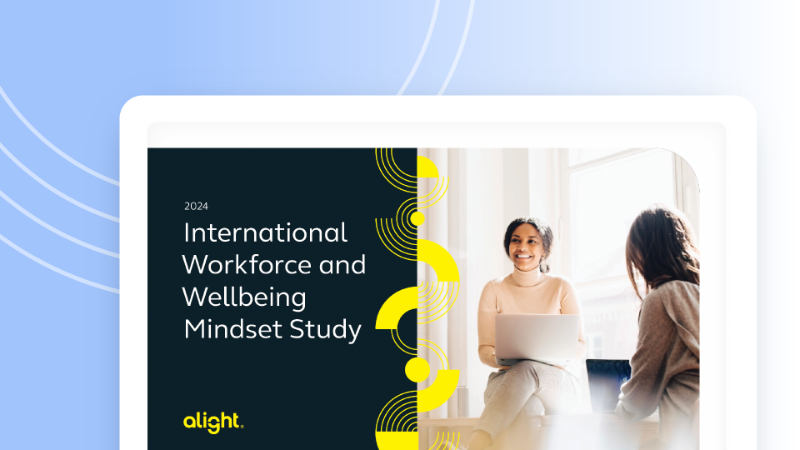
“You’ve come a long way, baby.” So proclaimed an infamous advertising slogan marketing cigarettes to women from the late 1960s to the mid-1990s. The phrase was intended to emphasize the progress women had made over the preceding decades. Women have certainly come a long way over the last century. However, they continue to struggle for equality in many areas, including pay, representation in top levels of government and business leadership — and, importantly, in closing the gender wellbeing gap.
Women are frequently perceived as taking better care of themselves than men, but their desire to prioritize wellbeing is often thwarted by factors beyond their control. This negatively impacts women’s perception of their personal wellbeing, which lags behind their male counterparts across all measures, according to the 2024 Alight International Workforce and Wellbeing Mindset Study. While 50% of men rate their overall wellbeing highly, just 38% of women feel the same. These numbers remain unchanged in terms of health and fitness. The gender wellbeing gap lessens only slightly when it comes to professional and career wellbeing (38% of women, compared to 49% of men), followed by mental and emotional wellbeing (37% to 47%) and social wellbeing (38% to 47%).
The gender gap is largest in the area of financial wellbeing, with 46% of men rating themselves highly, compared to just 31% of women. Just over a third (36%) of women say they have money left over at the end of the month, compared to 57% of men. Among those women who have managed to save, 55% are concerned the money they have or will save in the future won’t last, compared to 48% of men. Interestingly, men are slightly more pessimistic about their current financial situation, while women are more pessimistic about their financial futures, with 44% saying there’s no way they’ll be able to retire at the age they want, compared to just 36% of men.
of women say they have money left over at the end of the month, compared to 57% of men
The gender wage gap
While many factors surely contribute to women’s negative perception of their financial wellbeing, the pervasive gender wage gap is undoubtedly a major contributor. Women working full-time, year-round average just 83% of what men are paid. When part-time and seasonal workers are included, that number falls to 75%. This disparity led to the creation of Equal Pay Day, which aims to raise public awareness of the issue by marking how far into the year women must work to earn what men earned in the previous year. In a clear indication that women are losing ground in the fight for pay equity, Equal Pay Day for 2025 landed on March 25 — that’s 13 days later than in 2024.
Obviously, less money coming in means less money to pay bills, save for retirement or simply indulge in the discretionary purchases that bring added joy to life. No wonder two-thirds of women report high levels of stress, compared to 62% of men. The number-one source of stress? Finances, according to 60% of women, versus just 41% of men. In a related finding, nearly three-quarters (73%) of women say they experience job-related stress, but just 44% are likely to talk about it with their manager.
The one area where women fare slightly better than men is in the healthcare space. Just over half (53%) of women say they have regretted a healthcare decision in the last year. By contrast, 63% of men have such a regret, primarily because they took advice from someone who was not a healthcare professional.
Decoding the disconnect
As if all that wasn’t alarming enough, the majority of women are feeling decidedly cynical about their employers’ commitment to their wellbeing. Six in ten don’t believe their company cares about them and just 49% would trust the company to have their back in a wellbeing challenge. Sadly, just half of female workers feel they have control over their own wellbeing.
The good news is women are not only open to wellbeing support from their employer, they crave it. Two-thirds say they value or would value personalized health management (64%) and personalized financial management (65%). All too often, however, employees don’t have a thorough understanding of their total rewards — and fewer women than men (54% vs. 69%) say they know what is available to them. That’s truly unfortunate because female employees value wellbeing support and tools more than their male counterparts.
of women say they value or would value personalized health management and personalized financial management
86% of women who take advantage of wellbeing supports find them valuable
When asked if they want help with budgeting, debt or long-term savings strategies, 92% of women say they would find value in a spending tool and in short-term loans (vs. 78% of men). Women also place a high value on services like telehealth and digital therapeutics/preventative digital coaching. When they take advantage of wellbeing supports like a benefits guidance tool, for example, 86% of women find it valuable, compared to 78% of men. This highlights the gender wellbeing gap and the urgent need for more support.
Certainly, offering wellbeing programs targeting women is important. Programs that offer fertility planning, family building and menopause support continue to gain traction in the market. However, most employers have already invested in the tools, resources and guidance that would help women improve their wellbeing across all measures — physical, mental/emotional, financial and professional/career. They must find new ways to ensure that all employees female and male — recognize the availability of wellbeing benefits and perceive them as relevant and helpful.
The answer lies in a solution that is enabled by technology, but made personal through the expertise, empathy and support of highly trained consultants who provide crucial guidance as employees use their benefits, navigate challenges and actualize healthier, more financially secure lives.

Research reports


